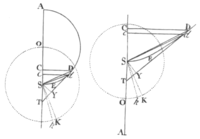Proposition XXXV. Theorem XI.
The ſame things ſuppoſed, I ſay that the area of the figure DES, deſcribed by the indefinite radius SD, is equal to the area which a body with a radius equal to half the latus rectum of the figure DES, by uniformly revolving about the centre S, may be deſcribed in the ſame time.. Pl. 16. Fig. 1.

For ſuppoſe a body C in the ſmalleſt moment of time deſcribes in falling the infinitely little line Cc, while another body K uniformly revolving about the centre S in the circle OKk, deſcribes the arc Kk. Erect the perpendiculars CD, cd, meeting the figure DES in D. Join SD, Sd, SK, Sk, and draw Dd meeting the axis AS in T, and thereon let fall the perpendicular SY.
Case 1. If the figure DES is a circle or a rectangular hyperbola, biſect its tranſverſe diameter AS in O, and SO will be half the latus rectum. And becauſe TC is to TD as Cc to Dd, and TD to TS as CD to ST; ex æquo TC will be to TS, as CD x Cc to ST x Dd. But (by cor. 1. prop. 33) TC is to TS as AC to AO, to wit, if in the coaleſcence of the points D, d, the ultimate ratio's of the lines are taken. Wherefore AC is to AO or SK as CD x Cc to ST x Dd. Farther, the velocity of the deſcending body in C is to the velocity of a body deſcribing a circle about
